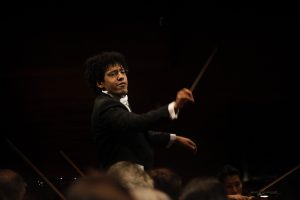Payare and the San Diego Symphony Open the 2021 Online Season with Wagner and Mozart
Under the baton of Music Director Rafael Payere, the San Diego Symphony opened its 2021 online season Friday, January 29, with a concert streamed from Copley Symphony Hall. Payare divided his program between Mozart’s exuberant Symphony No. 29 in A Major, K. 201, performed from the Copley Hall stage and a set of more somber works by Richard Wagner and Henri Tomasi arranged for brass and percussion played from the hall’s balcony.

Rafael Payare [photo (c.) Bjorne Bertheussen]
I actually prefer to hear Mozart’s symphonies performed with the transparent clarity of a small ensemble such as this, and Payare’s adroit attention to detail as well as his carefully calibrated tempos gave the entire Symphony No. 29 a buoyant, invigorating feel. In the slow second movement, Mozart’s lovely, opera aria like themes bloomed with deft assistance from the two oboes and two horns. A footnote: while Payare and the string players were all masked, these four wind players—you cannot play a wind instrument masked—were seated at the back of the Copley Hall stage with a suitable distance maintained between them and the string ensemble.
No doubt the need to suitably distance brass players determined the decision to have them perform standing in a wide semi-circle spread out across the hall’s spacious balcony. Payare conducted this ensemble from the center of the wide aisle that separates the balcony from the grand tier, an arrangement that provided excellent sight lines for the performers. In the past, the balcony has proven an auspicious location for hearty brass clusters in expansive Romantic works—I recall a thrilling performance of the Berlioz Requiem that proved this point admirably.
Payare’s choice of repertory for the brass was not flashy but majestic and somber: movements from two of Wagner’s operas (arranged by Robert King), the Prelude to Act 3 of Die Meistersinger and Siegfried’s Funeral March from Götterdämmerung. The Prelude opened with the mellow low brass summoning nocturnal serenity that was soon dispelled gracefully by sweetly understated trumpets. With the luxury of four trumpets and four trombones, the eloquently sustained rich texture of the brass gave a satisfying alternative to the traditional sonority of Wagner’s grand, lush string sections. Siegfried’s Funeral March unfolded in even darker solemnity, propelled by insistent cadences from the timpani and other members of the percussion section.
A seldom remembered French composer from the mid-20th century, Henri Tomasi had an affinity for winds and wrote several concertos for these instruments rarely chosen for concerto display. For Friday’s concert, Payare chose Tomasi’s Liturgical Fanfares for brass, written in 1947 and recycled in the 1950s into his opera Don Juan de Mañera. In the opera, this slow, stately music accompanies a Good Friday processional. Certainly, the Tomasi is a well-crafted work, but following Siegfried’s Funeral March, it seemed redundant.

Ken Herman, a classically trained pianist and organist, has covered music for the San Diego Union, the Los Angeles Times’ San Diego Edition, and for sandiego.com. He has won numerous awards, including first place for Live Performance and Opera Reviews in the 2017, the 2018, and the 2019 Excellence in Journalism Awards competition held by the San Diego Press Club. A Chicago native, he came to San Diego to pursue a graduate degree and stayed.Read more…
